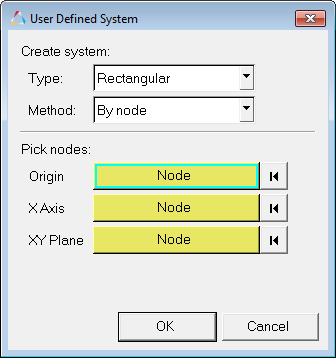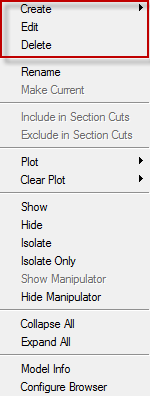User Defined Coordinate Systems |

|

|

|

|
|
User Defined Coordinate Systems |

|

|

|

|
The User Defined System dialog allows you to define your own coordinate systems and save the origin and orientation of these systems as a Session file or a Report. The dialog can be accessed three different ways:
| • | From the Model menu select Create > Systems. |
OR
| • | Right-click anywhere within the graphics area and select Create > System from the context menu. |
OR
| • | Right-click in a blank area within the Results browser and select Create > System. |

User Defined System dialog
If your model contains user defined systems, you can right-click on one of the existing systems and select Create > System, Edit, or Delete, from the context menu.

Results Browser User Defined Coordinate Systems Context Menu
Create system |
All user defined coordinate systems are static (or fixed). |
|||||||
Type |
Select one of the available coordinate systems:
You are able to make changes to the coordinate system Type (Rectangular, Cylindrical, Spherical) after it has been created, however once a system exists you are no longer able to make changes to the location of the coordinate system. |
|||||||
Method |
Select By node, By coordinates, or Circle center. |
|||||||
|
If By node is selected, the following User Defined System dialog is displayed:
User Defined System - By node dialog |
Pick nodes |
A minimum of three nodes need to be specified in order to define the orientation of the system. HyperView will automatically provide the x, y, z positions (coordinates) of the nodes at the time of definition. For the Linear or Modal animation modes, the undeformed position (model location) of nodes is considered in defining the system. For the Transient animation mode, the deformed position (current location at the time step) is considered. Once a coordinate system is created, the orientation remains fixed independent of how the model deforms. Note: Scaling does not affect the position of the nodes/points. The unscaled coordinates of the current node/point positions are used when defining nodes/points. User defined systems definitions are updated for Linear and Modal animation modes. The undeformed position (model location) of nodes is considered in defining the system. For Transient animation mode, the deformed position (current location at the time step) is considered. Once a coordinate system is created, the orientation remains fixed independent of how the model deforms. |
|
|
Origin/ |
Use the Node input collectors and the Select by ID dialog, in order to specify your desired nodes. |
|
If By coordinates is selected, the following User Defined System dialog is displayed:
User Defined System - By coordinates dialog |
Enter Co-ordinates |
Allows you to specify the coordinates which will be used to define the orientation of the system. Three points define a coordinate system. |
|
Origin: |
Defines the origin of the system. |
|
X-Axis: |
Defines the local X-axis (or R-axis for Cylindrical or Spherical systems). |
||
|
XY-Plane: |
Defines the X-Y plane (or the R-Theta plane for Cylindrical or Spherical systems). |
|
If Circle center is selected, the following User Defined System dialog is displayed:
User Defined System - Circle center dialog |
Pick 3 circle |
Allows you to define a coordinate system at the circle center (where the circle is defined by three nodes lying on the circumference of the circle). The origin of the system will be the circle center, and the x-axis of the system will defined along the vector between the circle center and the first selected node. Note - If a circle center could not computed using the three selected nodes (for example collinear nodes), then a default system will be created. The axes of this default system will align along the global axes. |
|
Node 1 |
Use the Node input collectors and the Select by ID dialog, in order to specify your desired nodes. |
|
|
||||||||||||
Delete |
Delete the selected system. Note - Only user defined coordinate systems can be modified or deleted. Coordinate systems from the input deck cannot be modified or deleted, they can only be reviewed. |
||||||||||||
Edit |
Use the User Defined System dialog to review and edit (or redefine) user defined coordinate systems.
User Defined System dialog Note - Only user defined coordinate systems can be modified or deleted. Coordinate systems from the input deck cannot be modified or deleted, they can only be reviewed.
System dialog
|
||||||||||||
OK |
Click OK to apply the settings/changes and exit the dialog. |
Cancel |
Click Cancel to disregard the settings/changes and exit the dialog. |
Saving to a session file is only through x, y, z coordinates of the origin and three direction cosine vectors for the orientation.
See Also: